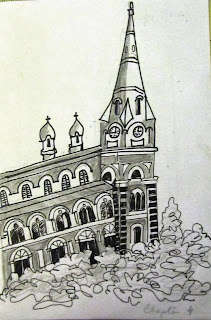 Talking of change, I think moving away from Kerala, my roots have made me cherish what I have left behind. Call it the ramblings of a Malayali slowly going senile away from the homeland (also a Malayali who knows she will go senile if she moves back to her hometown too) If only there were less of a love-hate tussle, if only there were fewer contradictions, less conflicted emotions about taking a decision of moving closer to my land of birth.
Talking of change, I think moving away from Kerala, my roots have made me cherish what I have left behind. Call it the ramblings of a Malayali slowly going senile away from the homeland (also a Malayali who knows she will go senile if she moves back to her hometown too) If only there were less of a love-hate tussle, if only there were fewer contradictions, less conflicted emotions about taking a decision of moving closer to my land of birth.My tongue keeps reminding me that I am growing older. The flavours I crave are no longer those from across the world - I enjoy them, but I don't crave them the way I now try to recapture the smells and flavours that lingered in my grandmother's and now my Amma's kitchen. Just as I began writing this post, I realised that this blog is filled with similar posts of yearning, something that was unconscious for long. But I no longer try to deny the power it has over me.
 In the many years that I have lived away from home, subsistence cooking was largely anything that was easy to cook and tasty too. And considering that I have lived in western India and abroad more than in the south, the choice of easy ingredients available to me defined the cuisine I cooked. So there I was, mastering rajma chawal and an assortment of paneer curries, rustling up chicken dishes adapted from north Indian recipes than the flavours I grew up with. I had the reasoning down pat too - who is going to spend time grating coconut? Not me! Who is going to meticulously choose all the ingredients that go into duplicating mom's dishes? Not me. Unlike north Indian dishes that are redeemable and salvageable at most stages of cooking, I often found Malayali cooking a difficult art to master - forget an ingredient or two and you know it doesn't taste authentic anymore! And if it doesn't hit the high notes that your mom's and grandmom's cooking hit, then you'd rather not play that music, but invent some of yours. The benchmark then can be set pretty low.
In the many years that I have lived away from home, subsistence cooking was largely anything that was easy to cook and tasty too. And considering that I have lived in western India and abroad more than in the south, the choice of easy ingredients available to me defined the cuisine I cooked. So there I was, mastering rajma chawal and an assortment of paneer curries, rustling up chicken dishes adapted from north Indian recipes than the flavours I grew up with. I had the reasoning down pat too - who is going to spend time grating coconut? Not me! Who is going to meticulously choose all the ingredients that go into duplicating mom's dishes? Not me. Unlike north Indian dishes that are redeemable and salvageable at most stages of cooking, I often found Malayali cooking a difficult art to master - forget an ingredient or two and you know it doesn't taste authentic anymore! And if it doesn't hit the high notes that your mom's and grandmom's cooking hit, then you'd rather not play that music, but invent some of yours. The benchmark then can be set pretty low.Since I moved to Delhi over four years back, I have been trying to bring bits of my mother's kitchen into mine. When you marry into a Punjabi family, you think they would be impressed with your love for roti over rice, your expertise in whipping up dals and chhole than an avial or a koottukari. Not the case for me! At every family gathering, there would be a demand for a dish from my kitchen - and you know by now which direction the cuisine suggestions would point!
 So there I was, on the phone with Amma every other day asking for one recipe after another. Initially, the flavour profiles were baffling and the fear of failing to reproduce them faithfully a big stumbling block. When did that ever deter the new family from sweetly requesting more Madrassi dishes? From the dosa breakfast that I was pretty adept at turning out, I graduated to the appams and ishtu. The crowning moment perhaps was when Amma asked me for my recipe for making chicken ishtu (stew). At home, we have always stuck to the veggies version, but here, I went out and improvised my own version, which till date is one of my fail-proof signature dishes. And then buckling under pressure, I made a sadya for Onam of 14 dishes (you better believe it!) for about 20 people! Yes, I had help, but I was the only one who knew what I was cooking! (Perhaps that helped too, that I wasn't serving it to discerning elders who'd nitpick on ingredients being out of sync! Instead I was serving a family who made me feel like I'd just won the Masterchef competition)
So there I was, on the phone with Amma every other day asking for one recipe after another. Initially, the flavour profiles were baffling and the fear of failing to reproduce them faithfully a big stumbling block. When did that ever deter the new family from sweetly requesting more Madrassi dishes? From the dosa breakfast that I was pretty adept at turning out, I graduated to the appams and ishtu. The crowning moment perhaps was when Amma asked me for my recipe for making chicken ishtu (stew). At home, we have always stuck to the veggies version, but here, I went out and improvised my own version, which till date is one of my fail-proof signature dishes. And then buckling under pressure, I made a sadya for Onam of 14 dishes (you better believe it!) for about 20 people! Yes, I had help, but I was the only one who knew what I was cooking! (Perhaps that helped too, that I wasn't serving it to discerning elders who'd nitpick on ingredients being out of sync! Instead I was serving a family who made me feel like I'd just won the Masterchef competition) These days, I have found myself craving dishes that I have stayed away from for the best part of my childhood. Avial has entered my list of all-time favourite dishes (I can hear Amma's evil laugh and I told you so!) Parippu dosas and an assortment of upmas are weekend treats at my place now. The joy of trying out new dishes, opening the lid off the vessel on the stove and inhaling deep to be transported back into Amma's kitchen - that's the subtle nudge and power of nostalgia.
These days, I have found myself craving dishes that I have stayed away from for the best part of my childhood. Avial has entered my list of all-time favourite dishes (I can hear Amma's evil laugh and I told you so!) Parippu dosas and an assortment of upmas are weekend treats at my place now. The joy of trying out new dishes, opening the lid off the vessel on the stove and inhaling deep to be transported back into Amma's kitchen - that's the subtle nudge and power of nostalgia.The cuisine that tingles your tongue is often one that lies dormant in your blood till one day you wake up - older and wiser - more appreciative of the wisdom in your Amma and Ammumma's cooking style, their precise measures and the unwillingness to experiment or tweak it too much lest the flavours they sought to recreate every time were irreparably tampered.
There was a time that I had laughed at the rigidity and promised myself never to be sucked into that. But even as I experiment and tweak recipes to suit my kitchen and convenience, I go back to trying to do it atleast once just like Amma does it - it makes me feel closer to her, smell the smells that surround her and to earn the delighted smileys she sends my way through Whatsapp when I tell her my dish tasted just like hers!





